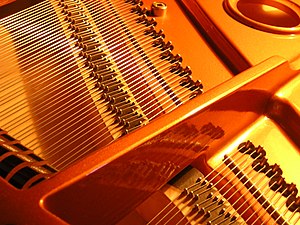 Image via Wikipedia
Image via Wikipedia
A. Of course not, but I do find many people are prone to think certain instruments as background or solely meant for accompaniment. I encourage these thinkers to discover how much emotion pureness can deliver. Often times as well, it's other instruments and voices that accompany a string, brass, woodwind or percussion instrument. If you're a skeptic, close your eyes and really listen next time you hear an instrumental song.
A little Strings 101 ...
There are three groups of string instruments:
Harps - the strings are contained within a frame
Lutes - the strings are supported by a neck and a bout ("gourd")
Zithers - the strings are mounted on a body
There are also three playing styles:
Plucked - like a guitar or harp
Bowed - like a violin or cello
Struck - like the piano or hammered dulcimer
I'm writing this post in hope to help more stories be told; however, strings are not the only method to tell a meaningful story. Everyone has their own voice, be it in the form of a musical instrument, hand, or spoken exclamation.
In college I took soprano saxophone lessons as well a voice class. I was actually a member of the university choir for two years to add to my 4 years of high school choir. I've also written my fair share of poetry. However, the piano, since my discovery at the age of 5, is the outlet that I can best tell a story.
Who knows, I may actually record while I'm singing along sometime. Only tomorrow will tell. Heck, I just released an electronica album ... but the accompaniment is not the piano. ;)

